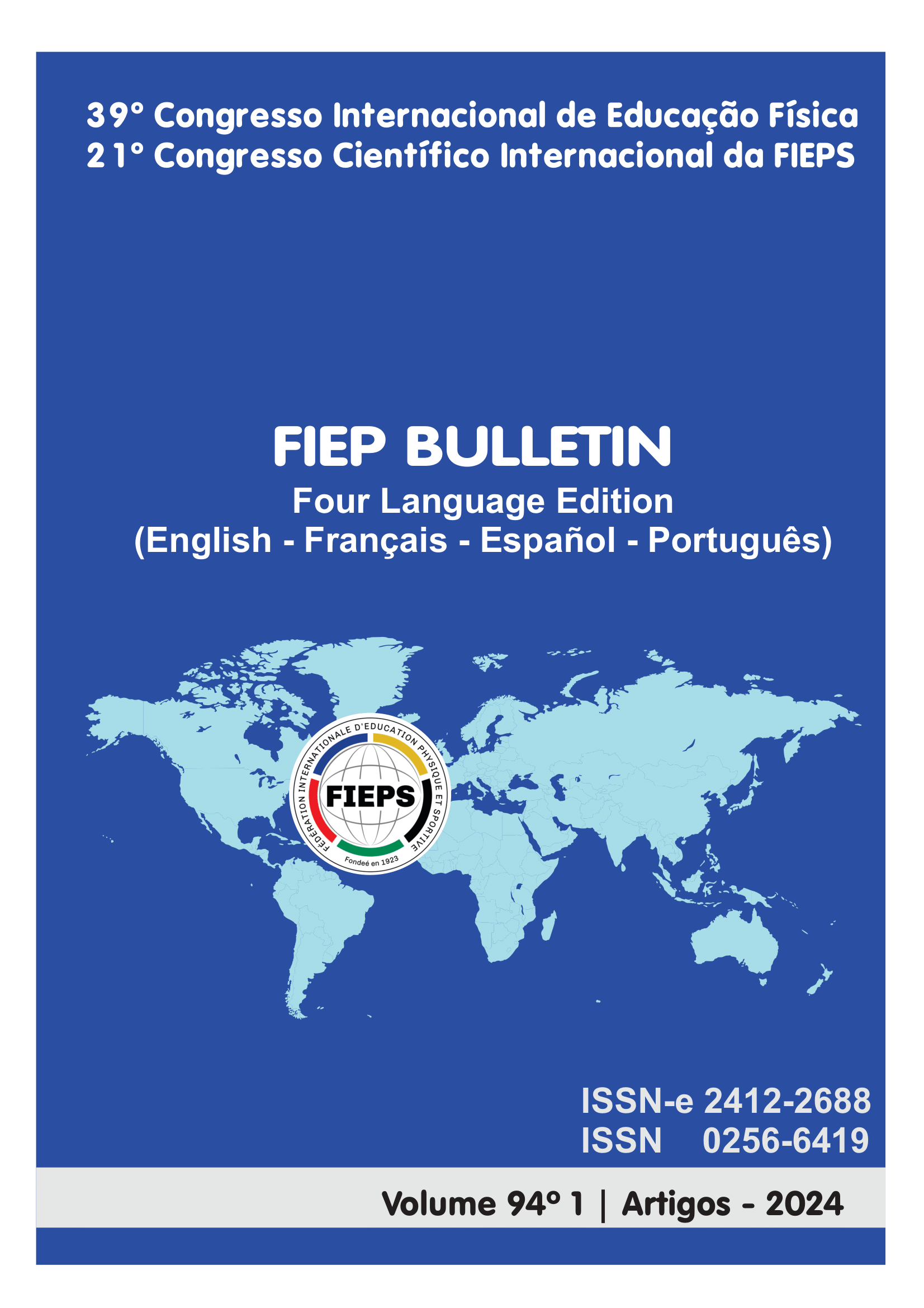EFEITO DE UM PROTOCOLO HIDROCINESIOTERAPÊUTICO EM UM PACIENTE COM OSTEOARTRITE
UM PROTOCOLO HIDROCINESIOTERAPÊUTICO EM OSTEOARTRITE
DOI:
https://doi.org/10.16887/fiepbulletin.v94i1.6810Keywords:
Osteoartrite, Hidrocinesioterapia, Qualidade de vida, Doença reumática.Abstract
Introduction: osteoarthritis is the most common pathology among arthritis and is clinically characterized by joint pain, functional limitation and reduced quality of life. The disease may be related to inflammatory and metabolic factors, in addition to the weakening of the immune system and systemic factors, and physiotherapy exercises are recommended for its treatment, such as hydrokinesiotherapy. Objective: to evaluate the effectiveness of hydrokinesiotherapy in patients with osteoarthritis. Methodology: the patient was assessed using the WOMAC questionnaire. The parameters analyzed were pain intensity, muscle stiffness and functionality. To assess pain, the Visual Analogue Scale was used. The Brazilian version of the SF-36 Quality of Life Questionnaire was also applied to assess the patient's subjective perception of her health and the impacts of osteoarthritis on her life. The qualitative and quantitative data were evaluated by regression analysis, to verify whether there was an improvement in the patient's quality of life and well-being. Results: improvement in the ability to perform daily activities, in the analgesic condition, in the stiffness and function of the joints and improvement in physical capacity. Conclusion: Hydrokinesiotherapy offers a safe and effective approach for treating osteoarthritis and promoting the well-being and quality of life of affected patients. The combination of improved physical function and reduced pain during treatment due to less impact on joints due to buoyancy and a generally more pleasant experience in the aquatic environment make hydrokinesiotherapy a valuable therapeutic option for people living with osteoarthritis.
Downloads
References
Referências
ABRAMOFF, B.; CALDERA, F. E. Osteoarthritis: Pathology, diagnosis, and treatment options. The Medical clinics of North America, v. 104, n. 2, p. 293-311, 2020. DOI: https://doi.org/10.1016/j.mcna.2019.10.007
ALLEN, K. D.; THOMA, L. M.; GOLIGHTLY, Y. M. Epidemiology of osteoarthritis. Osteoarthritis and Cartilage, v. 30, n. 2, p. 184-195, 2022. DOI: https://doi.org/10.1016/j.joca.2021.04.020
BARASSI, G. et al. Integrated thermal rehabilitation: A new therapeutic approach for disabilities. Advances in Experimental Medicine and Biology, v. 1251, p. 29-38, 2020. DOI: https://doi.org/10.1007/5584_2019_465
BARRETO, N.; FULLER, R.; DÓRIO, M. Métricas para osteoartrite. Métricas e Critérios, v. 21, n. 1, p. 62-71, 2022. DOI: https://doi.org/10.46833/reumatologiasp.2022.21.1.62-71
BEGO, D. S.; SHIWA, S. R. Recursos terapêuticos biohidricos. Editora e distribuidora educacional S.A. 2018. 168 p
FACCI, L. M.; MARQUETTI, R.; COELHO, K. C. Fisioterapia aquática no tratamento da osteoartrite de joelho: série de casos. Fisioterapia em Movimento (Physical Therapy in Movement), [S. l.], v. 20, n. 1, 2017.
GARBI, F. P. et al. Aquatic physiotherapy in the functional capacity of elderly with knee osteoarthritis. Fisioterapia em Movimento, v. 34, p. e34119, 2021. DOI: https://doi.org/10.1590/fm.2021.34119
HUNTER, D. J.; MARCH, L.; CHEW, M. Osteoarthritis in 2020 and beyond: a Lancet Commission. The Lancet, v. 396, n. 10264, p. 1711-1712, 2020. DOI: https://doi.org/10.1016/S0140-6736(20)32230-3
KRUGER, C. R. P.; SILVA, I. M.; SAMPAIO, A. C. R. I. A eficácia da hidroterapia em pacientes com osteoartrose no joelho. Revista de Iniciação Científica e Extensão, v. 4, n. 1, p. 595-602, 2021.
MEEREIS, E. C.; et al. Analise do equilibrio dinamico de idosas institucionalizadas apos hidrocinesioterapia. Rev bras geriatr gerontol. 16 (1) – mar/2013. DOI: https://doi.org/10.1590/S1809-98232013000100005
RIZZI, P. R. et al. Efeito da hidrocinesioterapia na forca muscular e na flexibilidade em idosas sedentarias. Fisioter mov. 23(4) – dez/2010. DOI: https://doi.org/10.1590/S0103-51502010000400004
SOCIEDADE BRASILEIRA DE REUMATOLOGIA (SBR). Osteoartrite (Artrose). São Paulo, 2022. Disponível em: https://www.reumatologia.org.br/doencas-reumaticas/osteoartrite-artrose. Acesso em: 18 mar. 2023.
SOUZA, A. A. de; MOURA, J. A. de; BASTONE, A. de C. Efetividade de um programa de fisioterapia aquática na capacidade aeróbia, dor, rigidez, equilíbrio e função física de idosos com osteoartrite de joelho. Fisioterapia Brasil, [S. l.], v. 18, n. 2, p. 165-171, 2017. DOI: https://doi.org/10.33233/fb.v18i2.794
SMITH, T. O. et al. The OMERACT-OARSI core domain set for measurement in clinical trials of hip and/or knee osteoarthritis. The Journal of Rheumatology, v. 46, n. 8, p. 981-989, 2019.
VERENGUE, B. R. et al. Proposta de protocolo para reabilitação de osteoartrose de joelho em cinesioterapia e hidroterapia. Revista Inova Saúde, Criciúma, v. 11, n. 2, p. 46-66, jul. 2021. DOI: https://doi.org/10.18616/inova.v11i2.5556
WILLETT, M. et al. Effectiveness of behaviour change techniques in physiotherapy interventions to promote physical activity adherence in lower limb osteoarthritis patients: A systematic review. PloS One, v. 14, n. 7, p.1-23, 2019. DOI: https://doi.org/10.1371/journal.pone.0219482
Downloads
Published
Issue
Section
License
Autores que publicam nesta revista concordam com os seguintes termos:- Autores mantém os direitos autorais e concedem à revista o direito de primeira publicação, com o trabalho simultaneamente licenciado sob a Licença Creative Commons Attribution que permite o compartilhamento do trabalho com reconhecimento da autoria e publicação inicial nesta revista.
- Autores têm autorização para assumir contratos adicionais separadamente, para distribuição não-exclusiva da versão do trabalho publicada nesta revista (ex.: publicar em repositório institucional ou como capítulo de livro), com reconhecimento de autoria e publicação inicial nesta revista.
- Autores têm permissão e são estimulados a publicar e distribuir seu trabalho online (ex.: em repositórios institucionais ou na sua página pessoal) a qualquer ponto antes ou durante o processo editorial, já que isso pode gerar alterações produtivas, bem como aumentar o impacto e a citação do trabalho publicado (Veja O Efeito do Acesso Livre).










